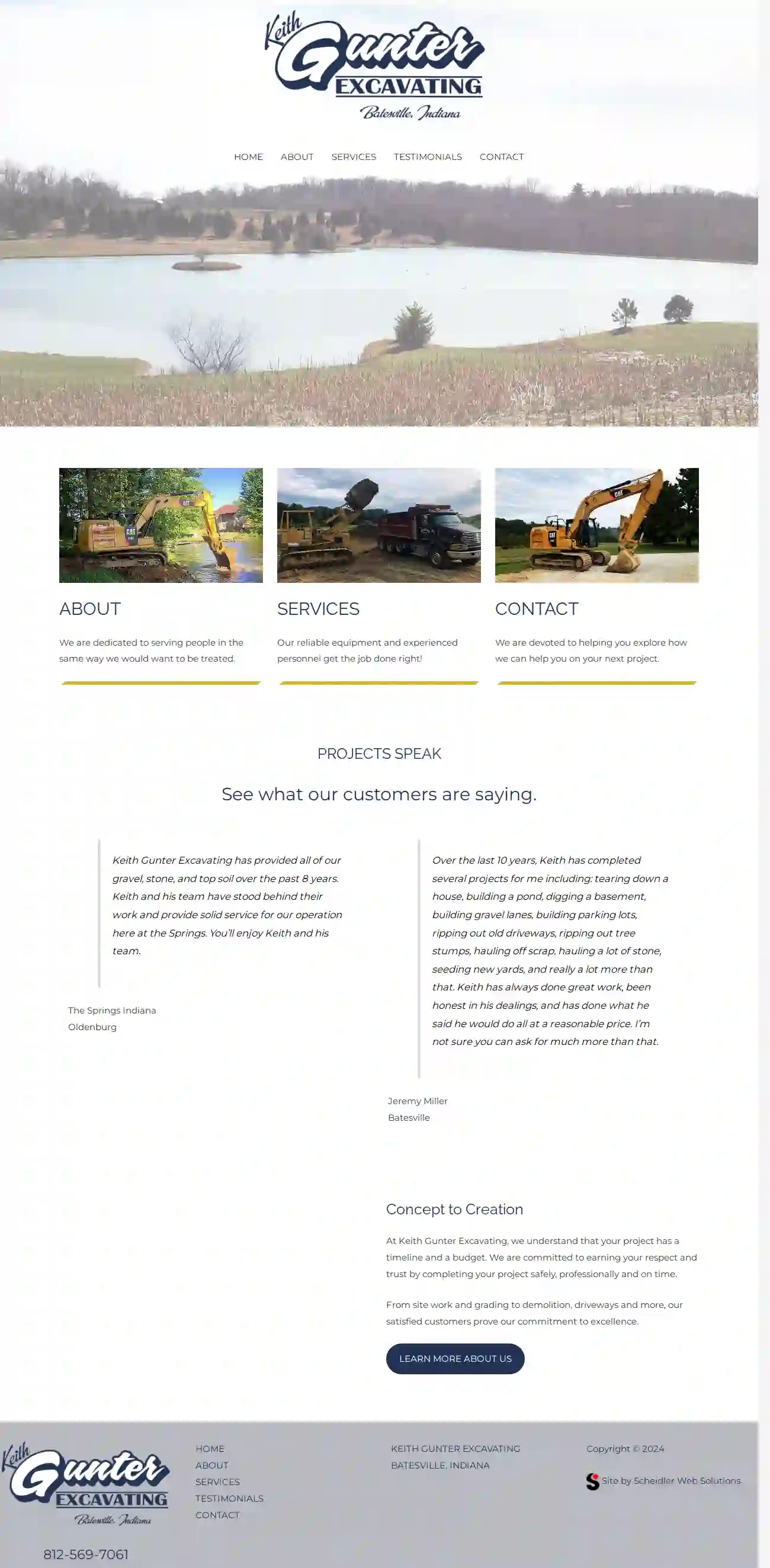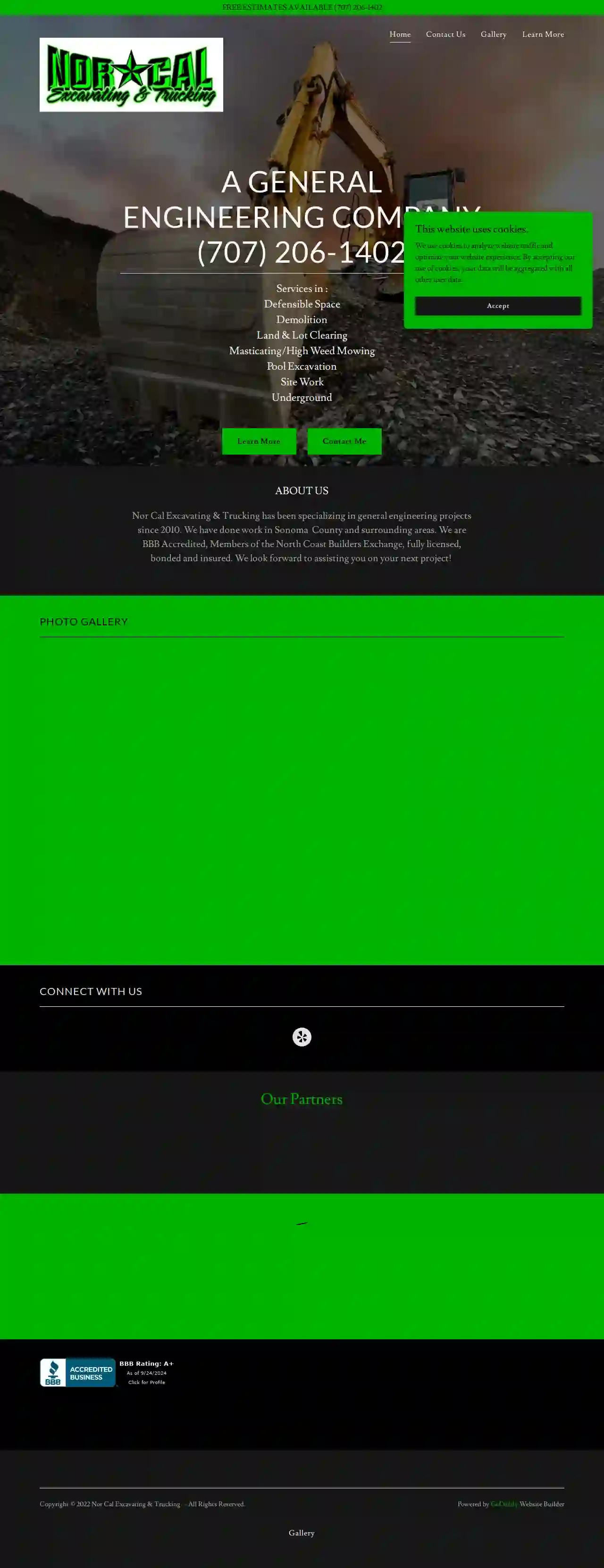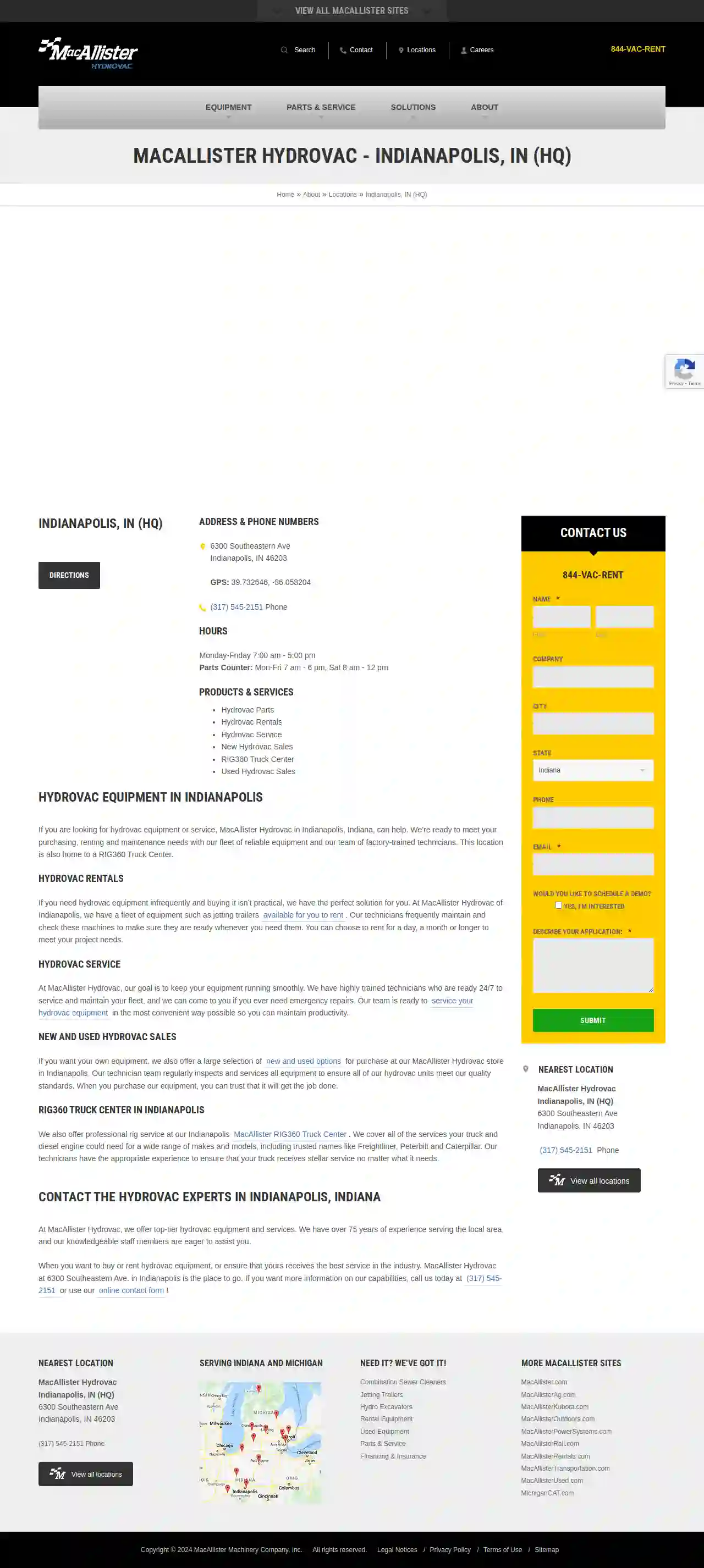Excavation Contractors Elkhart
Top Excavation Services in Elkhart
Receive multiple Excavation Services quotes for your project today! Compare profiles, reviews, accreditations, portfolio, etc... and choose the best deal.

Valpo Excavation & Septic
11101 Cumberland Crossing Drive, Suite 223, 1101 Cumberland Crossing Drive Suite 223, Valparaiso, 46383, USValpo Excavation & Septic: Your Trusted Excavation Partner in Northwest Indiana At Valpo Excavation, we are dedicated to delivering exceptional service with every project. Our team boasts years of experience in professional excavation, grading, trenching, site preparation, septic installation & repairs, and a wide range of other services. We are equipped with the most reliable equipment and skilled professionals to handle any excavation, septic, and foundation needs. When you require groundwork in Northwest Indiana, we are your one-stop solution. We understand that site preparation is crucial for any construction project. We offer a comprehensive suite of services, from grading and trenching to foundation installation. Our team at Valpo Excavation & Septic has extensive experience in heavy construction and will execute your sitework with precision and efficiency. Valpo Excavation is a locally-owned and operated company founded by Russ Buechs, a man driven by the American Dream. Russ is a family-oriented businessman committed to providing a fulfilling life for his family. This dedication led him to establish this family-owned, faith-based company from the ground up. He built this company with honesty, trustworthiness, and integrity as core values. His mission is to provide solid foundations for every home and business throughout Northwest Indiana. From initial site preparation to the laying of foundations and utilities, Valpo Excavation can handle it all with expertise and reliability. For over 15 years, Russ has been a dedicated professional in heavy construction. He possesses experience in every stage of home building, from foundation work to gutter installation. Additionally, his multi-year mission work in Guatemala provided him with valuable experience in concrete pouring. Russ's diverse experience makes him highly knowledgeable and prepared to deliver exceptional results. At Valpo Excavation, we provide excavation services, sitework, clear cutting, trenching, land grading, flatwork, and foundation work for any home or business in Northwest Indiana. We collaborate with both contractors and individual homeowners or business owners. Whatever your excavation needs may be, we have the solution.
- Services
- Why Us?
- Gallery
Get Quote
Keith Gunter Excavating LLC
515 reviewsBatesville, USWho We Are. Welcome to Keith Gunter Excavating! Keith Gunter Excavating is a third-generation, family-owned business based in Batesville, Indiana. With nearly 60 years of combined excavating experience, Keith and his team handle the ‘dirty’ work, Abby ‘digs’ handling the books, and the two youngest Gunter girls are ‘entrenched’ with looking cute and having fun. Keith Gunter Excavating offers a full-range of residential and commercial services across Southeastern Indiana. We are qualified to handle a variety of projects and will work hard to ensure you are completely satisfied!
- Services
- Why Us?
- Testimonials
- Gallery
Get Quote
Minix Construction Company
11990 North California Boulevard Suit 20 PMB 1135, Walnut Creek, 94596, USWelcome to Minix Construction Company. We are a Mass Excavation, Shoring and Dewatering Company. Servicing depths of 50 feet deep. Our company has been in business since 1982, providing quality work to the entire bay area.
- Services
- Why Us?
- Gallery
Get Quote
Indy Excavating & Utilities
3.76 reviews3512 S Harding St, Indianapolis, 46217, USAbout Indy Excavating & Utilities LLC At IEU, we strive for excellence in every project we undertake. With precision and expertise, we ensure that each task is executed meticulously, prioritizing safety as the cornerstone of our operations. Our unwavering dedication to integrity is the driving force behind our success, reflecting our promise to deliver superior services that stand the test of time in the great city of Indianapolis. We live and work by a simple creed: “Done Right. Done Safe. Done With Integrity.” We take pride in forming meaningful partnerships with both industry and community leaders, and forging connections that are bigger than the scope of our projects. Through these partnerships, we leave a legacy of service that extends beyond the earth we move.
- Services
- Why Us?
- Gallery
Get Quote
Coomler Contracting Inc.
51 reviews657 W 400 S, Cutler, 46920, USOur Story Committed to Excellence Coomler Contracting Inc. is a family owned and operated company that has been providing Kokomo, Lafayette, and the surrounding areas with quality that lasts since 1999. We are equipped professionals who tackle everything from complex large projects to smaller scale jobs. Not only do we complete projects from the preconstruction phase to completion, we also engage in subcontract work. Fueled by our commitment to excellence, we go the extra mile to make sure clients are completely satisfied with our work. Call us today to schedule a consultation on your projects needs.
- Services
- Why Us?
- Gallery
Get Quote
Sutton Excavating
110000 10th Line, Stratford, N0L 2J0, USSutton Excavating: Your Trusted Partner for Excavation Services Sutton Excavating is a family-owned and operated business with over 20 years of experience in the excavation industry. We are committed to providing our clients with high-quality, reliable, and affordable services. Our team of experienced professionals is dedicated to exceeding your expectations and delivering exceptional results. We understand that excavation projects can be complex and require a high level of expertise. That's why we take a personalized approach to every project, working closely with our clients to ensure their needs are met. From site preparation to utility installation, we handle all aspects of your excavation project with precision and care. At Sutton Excavating, we are committed to safety and environmental responsibility. We use the latest equipment and techniques to minimize our impact on the environment and ensure the safety of our workers and the public. Contact us today for a free consultation and let us help you bring your project to life.
- Services
- Why Us?
Get Quote
Nor cal excavating & trucking
1Windsor, USAbout Nor Cal Excavating & Trucking Nor Cal Excavating & Trucking has been specializing in general engineering projects since 2010. We have a proven track record of delivering high-quality work in Sonoma County and surrounding areas. Our commitment to excellence has earned us a reputation for reliability, professionalism, and customer satisfaction. We are proud to be BBB Accredited, Members of the North Coast Builders Exchange, and fully licensed, bonded, and insured. This means you can trust us to handle your project with the utmost care and expertise. Whether you need help with defensible space, demolition, land clearing, masticating, pool excavation, site work, or underground utilities, we have the experience and equipment to get the job done right. We are dedicated to providing our clients with the best possible service and exceeding their expectations. Contact us today for a free estimate and let us help you bring your next project to life!
- Services
- Why Us?
- Accreditations
- Gallery
Get Quote
Pat Mc Graw Excavating
1Aurora, USAbout Us With over 20 years in business and hundreds of satisfied customers, Pat McGraw Excavating is your trusted partner for all your excavation needs. We service the Tri-State area with over 30 pieces of heavy equipment at our disposal, ensuring no project is too big for us.
- Services
- Why Us?
- Gallery
Get Quote
Mana Construction Inc
52 reviews531 Ridge Ave, Vallejo, 94591, USYour Prefab ADU Construction Company in CA Mana is a family-owned construction company that serves the greater East and North Bay area. Founded in 2017 by Wife Nancy Cabrera and Husband Mauricio Cabrera, this power couple has incorporated all knowledge and experience from past projects to offer an unforgettable personal and professional building experience. They understand that building your dream home can be very frightening, but Mana is here to help. Mana Construction will make your building dreams come to life through professional experts and integrity. BUILDING YOUR FUTURE. At Mana, we pride ourselves on building a brighter future for you and your family. With years of experience, we ensure that every construction project is delivered on time and within budget. TRUST, RELIABILITY, AND EXPERTISE. We’re proud to be one of the most trusted construction companies in the industry. Our expert team comprises professional engineers, carpenters, electricians, and construction workers who can tackle any project size and deliver it with the highest level of professionalism. OUR PHILOSOPHY. Construction has always been a part of Nancy and Mauricio Cabrera’s lives. They have been fortunate enough to extend the blessing of constructing on-site and in the office with their crew. Together this couple has built a great network of sub-contractors who are skilled and ready to assist. From new builds to remodels to add-ons.Mana can offer turnkey capability when building a new home. Specialized in foundation and framing, they provide electrical, plumbing, HVAC, stucco, drywall, and paintwork. Mana is capable and ready to handle any task that may come their way.
- Services
- Why Us?
- Gallery
Get Quote
MacAllister Hydrovac
16300 Southeastern Ave, Indianapolis, 46203, USMacAllister Hydrovac: Your One-Stop Shop for Hydrovac Equipment MacAllister Hydrovac is your trusted source for all things hydrovac in Indianapolis, Indiana. We offer a comprehensive range of services, including new and used hydrovac sales, rentals, parts, and service. Our team of factory-trained technicians is dedicated to keeping your equipment running smoothly and efficiently. Why Choose MacAllister Hydrovac? Reliable Equipment: We offer a wide selection of high-quality hydrovac equipment from leading manufacturers. Expert Service: Our technicians are highly trained and experienced in all aspects of hydrovac equipment. Convenient Solutions: We offer a variety of rental and purchase options to meet your specific needs. 24/7 Support: We're available to assist you with any emergency repairs or maintenance needs. Our Services Hydrovac Rentals: Rent the equipment you need for short-term projects. Hydrovac Service: Keep your equipment running smoothly with our expert maintenance and repair services. New and Used Hydrovac Sales: Purchase new or used hydrovac equipment to meet your long-term needs. RIG360 Truck Center: Get professional truck and diesel engine service for a wide range of makes and models. Contact Us Today Whether you need to rent, buy, or service hydrovac equipment, MacAllister Hydrovac is here to help. Contact us today to learn more about our services and how we can meet your needs.
- Services
- Why Us?
- Gallery
Get Quote
Over 3,943+ Excavation Companies on our directory
Our excavation contractors operate in Elkhart and surrounding areas!
ExcavationHQ has curated and vetted Top Excavation Pros arround Elkhart. Find a top & reliable pro today.
Frequently Asked Questions About Excavation Contractors
- Basement Size: The larger the basement, the more excavation is required, increasing the cost.
- Soil Type: Excavating rocky or dense clay soil is generally more expensive than loose soil.
- Accessibility: Difficult-to-access sites might require specialized equipment or more labor, driving up costs.
- Foundation Type: The chosen foundation type (full basement, crawl space, slab) affects excavation needs.
- Underpinning: If underpinning (strengthening existing foundations) is necessary, it significantly increases costs.
- Disposal Fees: Hauling excavated soil to disposal sites adds to the overall expense.
- Clear the Area: Remove any obstacles, including vehicles, outdoor furniture, landscaping features, or structures, from the excavation zone and surrounding area.
- Mark Existing Features: Identify and mark underground utilities, septic tanks, sprinkler systems, or other buried elements you want to protect.
- Protect Landscaping: Use tarps or fencing to shield trees, shrubs, gardens, or other landscaping elements from damage.
- Provide Access: Ensure the excavation contractor has clear access to the work area, including gates wide enough for equipment.
- Discuss Logistics: Coordinate with the contractor regarding parking arrangements, material delivery, and any special instructions or concerns you might have.
- Project Size and Scope: Larger, more complex excavations naturally take longer.
- Soil Conditions: Rocky or challenging soil types can slow down progress.
- Site Accessibility: Limited access might require more time for maneuvering equipment and hauling materials.
- Weather: Inclement weather can cause delays.
- Permitting and Inspections: Waiting for permits or inspections can extend the timeline.
- Sloped Property: Your property has a significant slope, making it prone to soil erosion or landslides.
- Creating Usable Space: You want to level off a sloped area to create a flat surface for patios, gardens, or other outdoor spaces.
- Preventing Damage: Erosion is threatening existing structures, driveways, or walkways.
- Landscaping Features: You're incorporating tiered gardens, raised beds, or other landscaping elements requiring soil retention.
How much does it cost to excavate a basement?
How do I prepare my property for excavation?
How long does an excavation project take?
How do I know if I need a retaining wall?
How much does it cost to excavate a basement?
- Basement Size: The larger the basement, the more excavation is required, increasing the cost.
- Soil Type: Excavating rocky or dense clay soil is generally more expensive than loose soil.
- Accessibility: Difficult-to-access sites might require specialized equipment or more labor, driving up costs.
- Foundation Type: The chosen foundation type (full basement, crawl space, slab) affects excavation needs.
- Underpinning: If underpinning (strengthening existing foundations) is necessary, it significantly increases costs.
- Disposal Fees: Hauling excavated soil to disposal sites adds to the overall expense.
How do I prepare my property for excavation?
- Clear the Area: Remove any obstacles, including vehicles, outdoor furniture, landscaping features, or structures, from the excavation zone and surrounding area.
- Mark Existing Features: Identify and mark underground utilities, septic tanks, sprinkler systems, or other buried elements you want to protect.
- Protect Landscaping: Use tarps or fencing to shield trees, shrubs, gardens, or other landscaping elements from damage.
- Provide Access: Ensure the excavation contractor has clear access to the work area, including gates wide enough for equipment.
- Discuss Logistics: Coordinate with the contractor regarding parking arrangements, material delivery, and any special instructions or concerns you might have.
How long does an excavation project take?
- Project Size and Scope: Larger, more complex excavations naturally take longer.
- Soil Conditions: Rocky or challenging soil types can slow down progress.
- Site Accessibility: Limited access might require more time for maneuvering equipment and hauling materials.
- Weather: Inclement weather can cause delays.
- Permitting and Inspections: Waiting for permits or inspections can extend the timeline.
How do I know if I need a retaining wall?
- Sloped Property: Your property has a significant slope, making it prone to soil erosion or landslides.
- Creating Usable Space: You want to level off a sloped area to create a flat surface for patios, gardens, or other outdoor spaces.
- Preventing Damage: Erosion is threatening existing structures, driveways, or walkways.
- Landscaping Features: You're incorporating tiered gardens, raised beds, or other landscaping elements requiring soil retention.